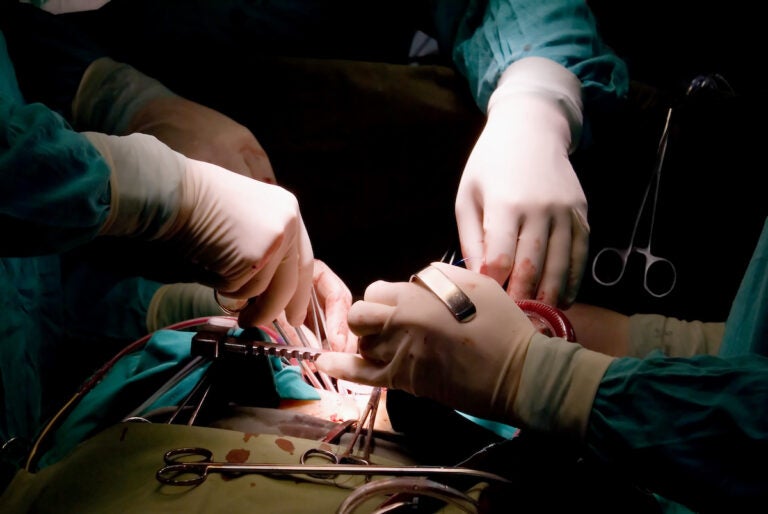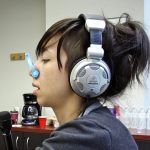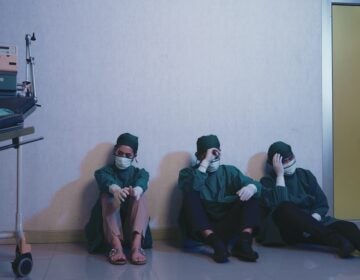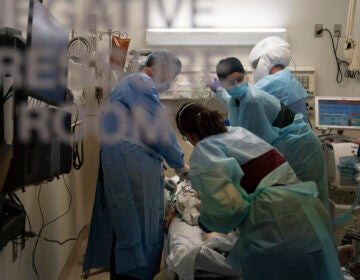Anatomy of a medical mistake: What led one surgeon to perform the wrong procedure — and then go public about it
Hand surgeon David Ring reflects on the mistake that shook him to his core — and what caused it.
Listen 12:46
Hands of surgeons in operation room. (Bigstock/beerkoff)
This story is from The Pulse, a weekly health and science podcast.
Find it on Apple Podcasts, Spotify, or wherever you get your podcasts.
It was a mistake that never should’ve happened — the kind of mistake that haunts the dreams of surgeons.
And yet, in 2008, it happened to David Ring, an experienced hand surgeon at Massachusetts General Hospital.
Sixteen years later, he still remembers the exact moment he realized what he’d done. It was close to the end of the day, and Ring was in his office taking care of his operative notes and billing for the day’s procedures. As he shuffled through the paperwork, his gaze fell across the records for his final patient of the day. That’s when it hit him: He’d performed the wrong surgery.
The patient had needed a trigger finger release — a procedure designed to “unstick” a stiff finger. Instead, Ring had performed a carpal tunnel release, in which a ligament at the base of the palm is cut in order to relieve pressure on the pinched median nerve.
“It’s hard to put into words how bad this feels,” Ring said. “It’s like there’s no air. It’s like the floor just drops. There’s a split second where the mind can imagine that it didn’t happen. And then you’re just quickly beyond that; it’s like, it happened.”
In the weeks and months after, Ring became obsessed with figuring out one thing — how it had happened, and why.
A mental error
In hindsight, Ring realized that the path toward his mistake had started before he even got to the hospital.
That day, Ring had six surgeries scheduled — not a lot for a hand surgeon, since they tend to do smaller procedures — three medium-sized surgeries that would require full anesthesia, and three smaller ones using local anesthesia, including two carpal tunnel releases. As he got ready that morning, he organized the procedures in his mind.
“And so, in my mind, I simplified that to the three medium-sized surgeries and three carpal tunnel releases,” Ring said.
There was just one problem — the final small surgery, his last of the day, wasn’t a carpal tunnel release; it was a trigger finger release. It was the kind of trivial mental error he might’ve easily corrected — if his day hadn’t veered into chaos.
Subscribe to The Pulse
A distressed patient
The first three surgeries went fine, but things started going haywire with his first carpal tunnel release.
“That patient, I knew, was very nervous about the shot for the local anesthetic,” Ring said.
It was a fear that Ring would later discover bordered on phobia, but at the time, he thought it could be managed with a little extra TLC. And so, before the procedure, he went into the preoperative area to talk her through the surgery and ease any concerns. When she seemed calm enough, they wheeled her into the operating room, and performed the surgery. But when he’d finished, and they took down the drape blocking Ring’s view of the patient’s face, he saw something that stopped him in his tracks.
“What I saw was a traumatized person, like just really distraught,” he said. “It was heart wrenching and I took a moment to apologize and connect with her and soothe her. But it really affected me — her anxiety, her experience affected me.”
It wasn’t that Ring felt like he’d been negligent, or could’ve done anything different to settle her fears; it was that Ring had become a physician to help people. And at that moment, he felt like he’d done the opposite.
“It was bad because it was like a violation of a trusting relationship,” Ring said. “I felt like we had worked through this together and then all of a sudden it became — we weren’t together and that she was harmed by me.”
Ring felt awful — emotionally and physically, as the anxiety and adrenaline pulsed through his body. But he still had two more surgeries that day. So he pulled himself together, and went on to the next procedure, another carpal tunnel release.
The procedure went smoothly.
But as he was gearing up for his sixth and final surgery of the day, staff informed him that the procedure was being moved to another operating room because other surgeons were running behind. Since that would mean a delay, Ring decided to go do an inpatient consult on another floor. As he was on his way back down, the nurse who’d helped with the first carpal tunnel surgery, the woman with the fear of anesthesia, stopped him.
“And she says, ‘Can you please come over here? She’s decompensating,’ which is sort of a word we use to mean, it could be medically going bad. But in this case, it just meant her anxiety and her bad feelings, her emotions were really spiraling.”
He found the patient in an agitated state, crying and hyperventilating — “almost unreachable,” Ring said. He sat down by her bedside and tried to calm her down.
“I think it was helpful,” he said. “But again, her emotions transferred to me. There’s that emotion contagion or stress contagion. And I again took on that mindset and that physiology of stress.”
Ring was thrust back into the same awful state he’d been in right after her surgery. And so, on his way to his final procedure of the day, he made a fateful resolution in his mind: “I’m going to do the best carpal tunnel release I’ve ever performed!”
Chaos in the OR
Strangely, Ring had known as little as a few hours ago that the final patient wasn’t there for a carpal tunnel release – she was there for a trigger finger release, a procedure designed to make it easier for a patient to bend a stiff finger. He’d even examined the patient, a middle-aged Caribbean woman who we’ll call Alma to protect her privacy, while running her through the preoperative prep.
This usually wasn’t something that surgeons did, but since Alma spoke only Spanish, and there was no interpreter available, Ring — who also speaks Spanish — was asked to fill in. He guided her through informed consent, examined her finger, and walked her through the risks and benefits of the surgery.
But after his second encounter with the anesthesia-phobic patient, it was as if all of that had been wiped clean from Ring’s mind.
The delay also caused other ripple effects.
First, it resulted in a changeover in staff, which meant that the nurse who had prepped Alma and performed the safety check would no longer be present for her surgery.
Second, the operating room they’d been relocated to wasn’t fully prepared. The tourniquet they needed to control bleeding was missing, so the circulation nurse had to run out and fetch a new one, putting her behind on her work.
And then there were other hiccups. When Alma’s arm and hand were washed, it wiped off the site marking — the “X marks the spot” used to ensure surgeons are operating in the right place.
Most importantly, Ring says, the team never performed a “time out” – a pre-surgery huddle, in which they review who the patient is, what procedure they’re about to do, where exactly it’s being done, and any concerns they might have beforehand.
It’s a protocol recommended by the World Health Organization that Ring’s hospital was one month away from officially adopting. Ring usually did his own version of a time-out anyway, but this time, he was frazzled and upset; the room was in chaos; and, as he later discovered, his nurse had assumed that his chit-chat with the patient in Spanish had been him confirming the procedure details.
The cherry on top of the confusion sundae? A shift change right in the middle of the surgery — the second time that day Alma’s team had been switched out for a new one.
The procedure itself went well — it was only afterwards, sitting in his office, that Ring realized what he’d done.
Making things right
The first thing Ring did after realizing his mistake was to call the operating room and tell them what happened. Then he went to do the hardest part — apologize to Alma.
“I remember that moment,” Ring said. “She was in a chair sitting up, so I got down to her level, which meant I was on my knee. I said, ‘I made a mistake.’”
As Ring started to cry, Alma sat listening quietly.
“She’s a woman of very few words, so she’s just listening as I speak,” Ring said. “I said, ‘If you want me to, I can take care of the trigger finger for you.’ And she said yes.”
Ring remembers the somber silence that settled over the unit as they again prepared for surgery. As he was walking down the hall, he spotted the director of the operating room approaching, and felt his stomach clench.
“And in my mind, I’m thinking, ‘I’m in for it now,’” Ring said. “‘He’s going to punish me. He’s going to yell at me. He’s going to [not let me] operate for a while.’ And what he said actually was, ‘How are you doing?’” And this is the part where I tear up usually because the moment that I was being the hardest on myself that I’ve ever been or one of the hardest, he just cared about me.”
After their talk, Ring pulled himself together, and performed the trigger finger release on Alma. Then he discharged her and went home.
“And that was a, needless to say, very sleepless night,” Ring said.
The next day, Ring called Alma’s son to check in on how she was doing. They’d spoken before, when Ring initially called to confess his mistake, and the son had been understanding and gracious. But now on the phone, Ring could sense in the son’s voice that the mistake had finally hit Alma. He asked if Alma had lost her trust in him, and the son confirmed.
“And I said, ‘I totally understand. I’ll make sure she gets good care going forward.’”
The post-mortem of a mistake
The days and weeks after were filled with soul-searching for Ring — and the hospital. He had meetings with his colleagues, along with the Quality and Safety Committee, to review what had happened, why it had happened, and how it could be avoided in the future. It’s the kind of mistake a lot of hospitals would be eager to bury as quickly as possible, but the administrators at Ring’s hospital did the opposite. They proposed that he present the case at an upcoming conference, and write it up for the New England Journal of Medicine — one of the most respected and widely read publications in medicine.
For someone else, it might’ve been a nightmare scenario — being asked to air the biggest mistake you’ve ever made in front of not only your colleagues, but the whole world; all the people who Ring liked and respected; the people who might be deciding whether or not to hire him one day. But for Ring, the suggestion felt like an opportunity for catharsis.
“Now, remember, I’m already a quality and safety advocate and champion in my hospital, so it was an easy yes,” Ring said. “But it was also an easy yes because the thing that I dreaded most is walking down the hall past a colleague and they know the event that I’ve been through and , not being sure whether we can talk about it or not. So I really wanted to get up and talk about it. And I wanted to make something good out of it. I wanted to do the best I could with something that was awful and make a pain point into something creative and useful. So that was a huge part of the healing process for me; talking about it, being open about it.”
And so Ring dove head-first into a fact-finding mission that would eventually reveal that a convergence of factors — the mental shortcut that made him think he was performing three carpal tunnels that day; the emotional turmoil from his earlier patient; the last-minute room and staffing changes; the language barrier that sowed confusion — all of it had contributed to Ring performing the wrong surgery.
Going public with his mistake
There ended up being no lasting damage for Alma. Her trigger finger was fixed, and the tendon Ring had cut during the carpal tunnel release would heal on its own. But for Ring, and likely Alma, the ordeal imprinted a lasting trauma — trauma that Ring wanted to make some meaning out of, some lasting good.
And so once he’d pieced everything together, Ring presented the case before a conference of his peers. Later, he published his account in the New England Journal of Medicine, and soon found that he was being asked to speak about it everywhere.
“And after I spoke about it, I’d go to the back of the room, and people would swarm around me and they all wanted to tell their story,” he said. “And a part of their story was often, ‘I was punished. I was shamed.’ It was not the good outcome that I had, which I was drawn in and I was supported.”
There’s a famous report on medical errors that was published in 1999 called “To Err is Human.” And Ring says that’s a sentiment people in medicine seem to understand — that mistakes happen, and that’s why it’s important to have what he calls a good safety culture — multiple, duplicated safety nets, so that when one fails, another one catches the mistake.
“Everyone who’s trained in quality and safety learns early on about James Reason’s Swiss Cheese theory,” Ring said.
The idea behind the Swiss Cheese theory is that safety systems are like slices of Swiss cheese — they all have holes. But if those defenses are layered, one on top of the other, then each additional layer will prevent an accident from slipping through the holes.
“And the only way an error leads to harm is if it goes through each of those safety systems, if the holes in the Swiss cheese line up,” Ring said. “And there couldn’t be a more perfect example of that. My mind was stuck on carpal tunnel; there was the, ‘I’m going to do the best carpal tunnel release I’ve ever done,’ because of the anxiety I was feeling because the patient had a bad experience. And that’s the error. And then the error making it through all the layers of Swiss cheese because of everything I mentioned, there’s so many things that could have kept my error from causing harm.”
But Ring says safety culture isn’t just about having the right protocols in place – it’s about health workers feeling safe themselves about reporting their mistakes. Safe from punishment, safe from shaming, safe from being fired.
“The tendency is to assume that somebody who made an error is sloppy or mistake-prone or inattentive,” Ring said. “And that’s incorrect. Everyone errs.”
Which is why Ring — who today, in addition to his work as an orthopedic surgeon and hand specialist, also serves as associate dean at Dell Medical School at the University of Texas — has, in the years since, become even more of an advocate for a strong safety culture. And why, whenever asked, he readily shares the story of his mistake.
“There’s always something distracting us, or on our mind — we’re worried or we’re tired or we’re hungry,” Ring said. “Skilled, knowledgeable, effective people are going to make errors and [we need to] set up a system to catch those errors before they cause harm, and support people when they make an error. And you have to fight for that every day.”
WHYY is your source for fact-based, in-depth journalism and information. As a nonprofit organization, we rely on financial support from readers like you. Please give today.







